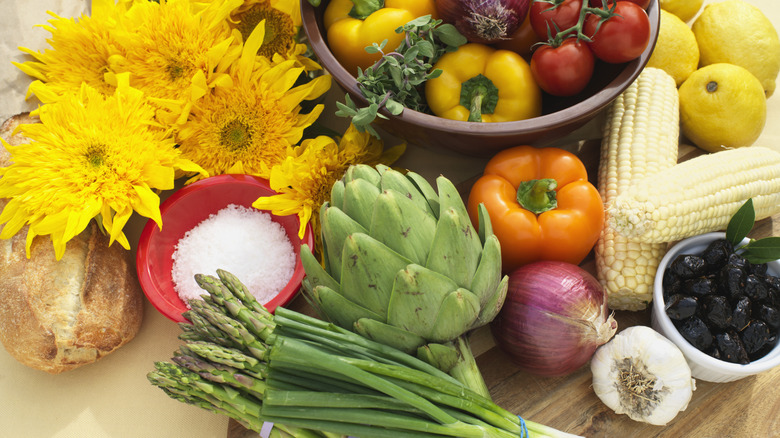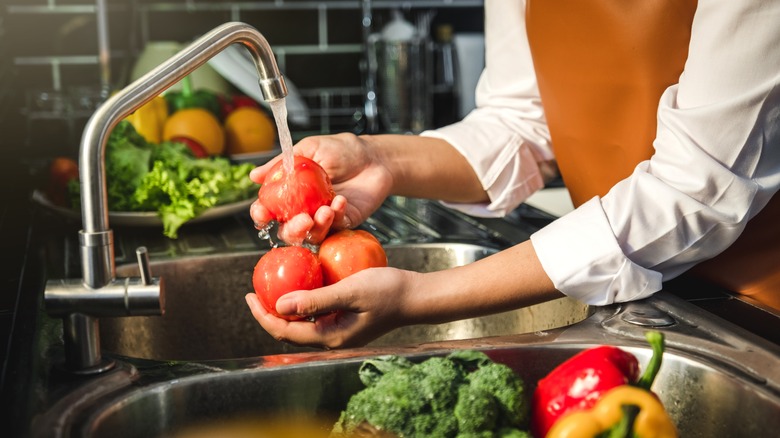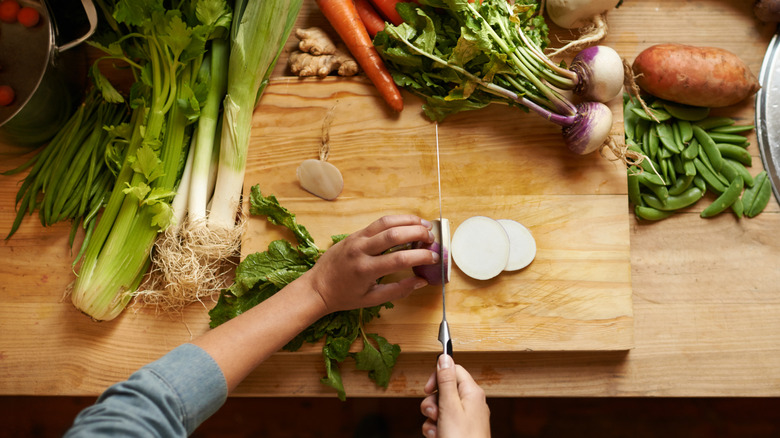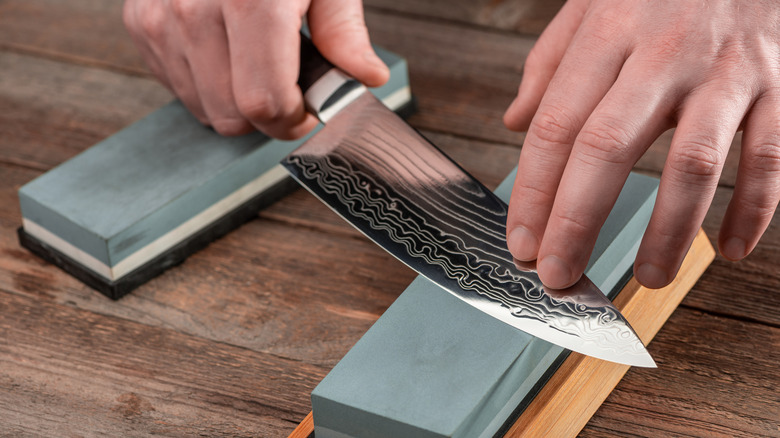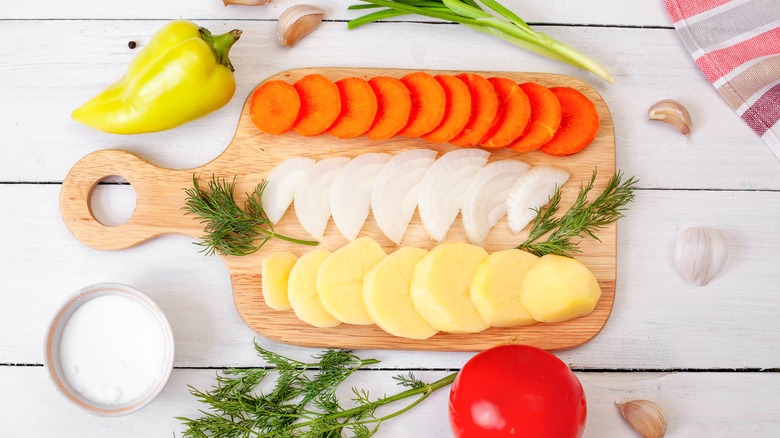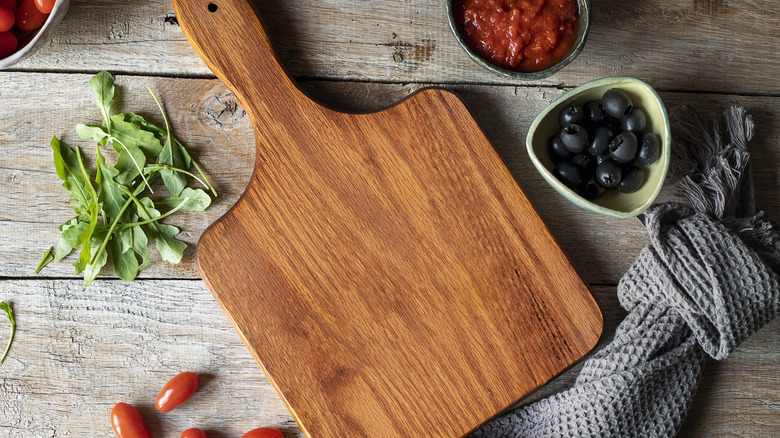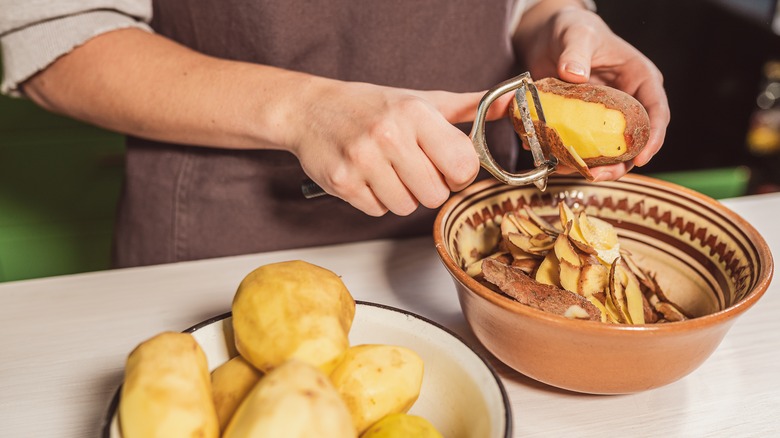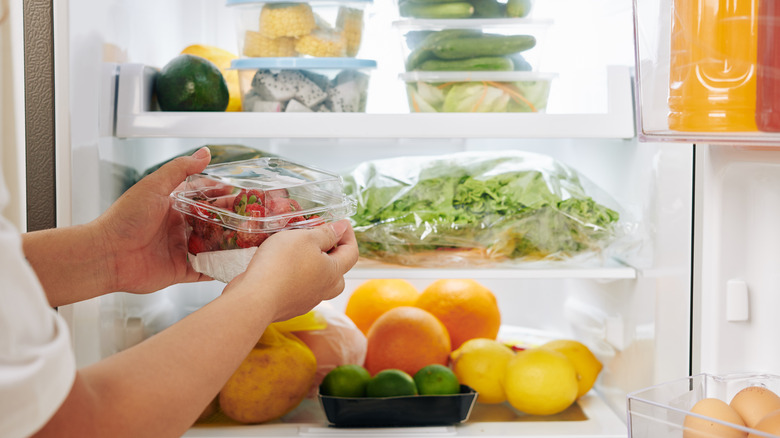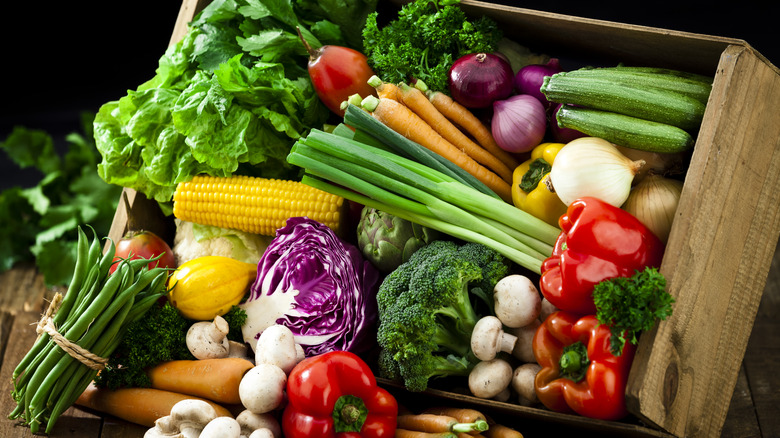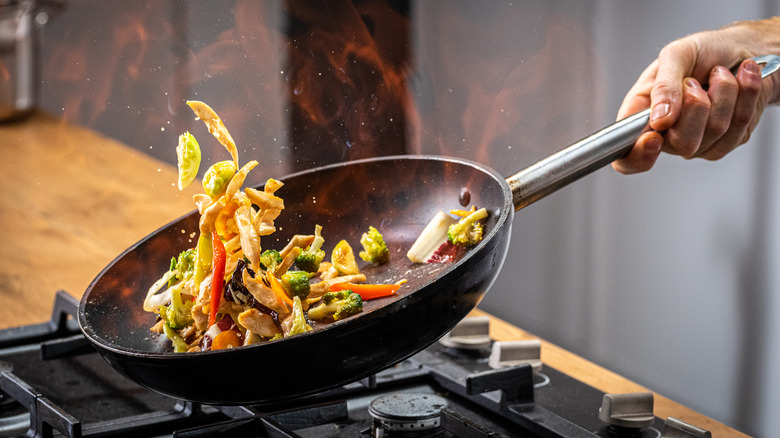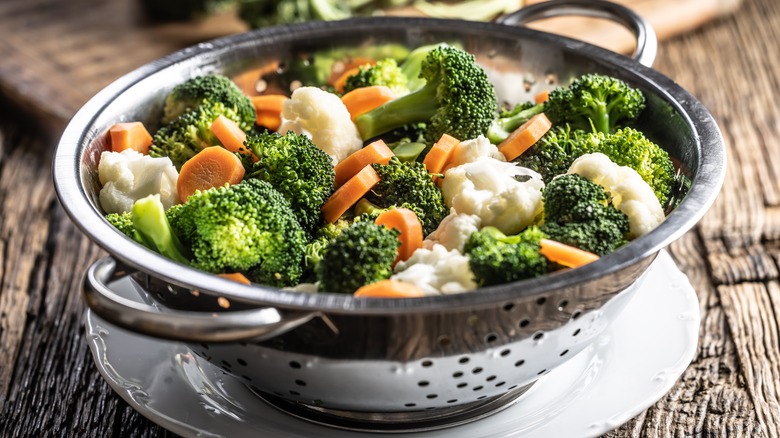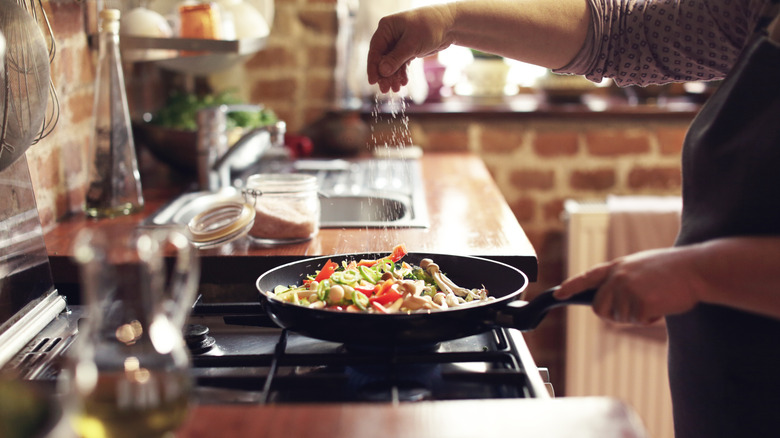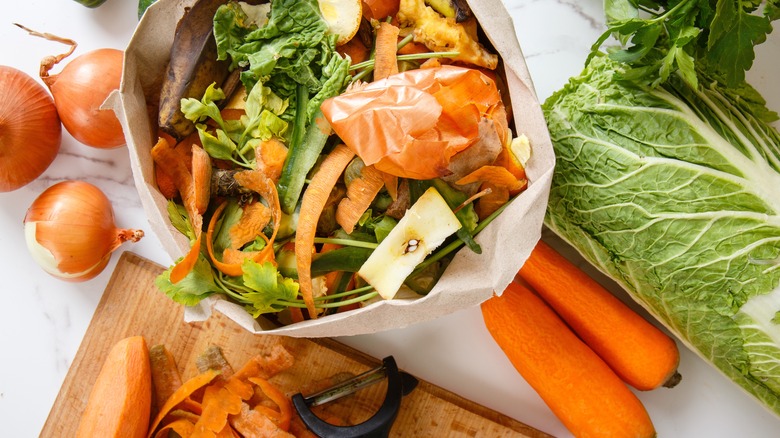12 Mistakes We All Make When Prepping Vegetables
When it comes to cooking meals, vegetables are often the unsung heroes, overshadowed by fancy proteins and main carbs. Yet, when prepared properly, vegetables have the power to elevate a dish with their vibrant colors, nutrients, and flavors — totally stealing the show. While prepping vegetables seems straightforward compared to other meal components, how we prepare our veggies can make all the difference between a mundane meal and a culinary masterpiece.
Whether you're a seasoned cook or a novice one, we are all prone to making mistakes when prepping vegetables, not realizing that a simple act can make all the difference. For instance, we depend on vegetables for vitamin intake — with the USDA recommending at least two and a half cup of consumption daily — but improper preparation can actually strip away many nutrients.
From storing and peeling to cooking and seasoning, keep these common mistakes in mind the next time you prep your vegetables. By changing the way you do these things, you give these humble ingredients the attention they deserve and take a step closer to preparing your meal like a pro.
1. Not washing your vegetables properly
The Food and Drug Administration (FDA) estimates that approximately 48 million people get sick from food contamination each year. One effective way to prevent this is by thoroughly washing your vegetables, as they can harbor dirt, bacteria, and pesticides. Washing your vegetables under running water is better than soaking because this will actually rinse away the germs. For firmer produce like potatoes and carrots, use your hand or a scrubbing brush to clean thoroughly.
The FDA also advises you to wash your vegetables before peeling them. This may seem counterintuitive, because why wash the outer part that you won't be using anyway? But this step is crucial because if you don't wash before you peel, any contaminants on the skin will transfer to the flesh when you use the knife or peeler. After peeling, it's also a good idea to give them another rinse to make sure everything is clean.
Drying your vegetables is just as important as washing them. After washing, make sure they are properly dried, as damp vegetables can become breeding grounds for bacteria even after they are cleaned. You can use a salad spinner for leafy greens or pat them dry with a dish towel.
2. Chopping way too soon
Chopping vegetables in advance can be a time-saving strategy for preparing meals, but it comes with drawbacks. One significant disadvantage is that chopping vegetables too far ahead can cause them to lose their freshness and nutritional value. Many vegetables start to lose nutrients as soon as they are cut due to oxidation and exposure to light. Vitamins C, A, and E, which are antioxidants, are particularly vulnerable to this effect.
The good news is that some vegetables, especially root vegetables like sweet potatoes, onions, and carrots, can be peeled and chopped two to three days in advance without significant loss of freshness or nutrients. Similarly, hard vegetables such as broccoli, cabbage, and Brussels sprouts can be prepared three to four days ahead. On the contrary, vegetables with a high water content, like cucumbers and tomatoes, tend to lose freshness within a day or two. Leafy greens such as spinach, lettuce, and herbs are best prepared on the day they will be consumed or cooked.
To preserve the freshness and nutrients of pre-chopped vegetables, store them in airtight containers or resealable plastic bags and put in the fridge. This helps to minimize exposure to air and light, which can degrade their quality over time. Also, make sure to keep them dry and store different vegetables separately to prevent spoiling.
3. Cutting with dull knives
Using a dull knife when prepping vegetables can be not just frustrating but also potentially dangerous. A dull knife has poor traction and requires more force to cut through vegetables, increasing the risk of slipping and cutting yourself. Moreover, the pressure exerted by a dull knife can cause more damage to the cells and fibers of your vegetables.
Vegetables with high water content, such as celery and tomatoes, are particularly affected by the use of a dull knife. They tend to lose more juices when cut with a dull blade, which can affect their texture and flavor. Even leafy vegetables can be affected, becoming soggy and losing nutrients as their juices smear on the knife blade or cutting board. Moreover, cutting onions with a dull knife can lead to more tears. The increased pressure applied to the onion cells can cause them to release more tear-inducing chemicals, making the chopping experience more unpleasant.
In addition, using a dull knife can compromise the texture and appearance of your vegetables, especially if you're aiming for precise cuts or slices. To avoid these issues, it's essential to keep your knives sharp. You can use a knife sharpener or have your knives professionally sharpened regularly. A sharp knife will not only make prepping vegetables easier and safer but will also result in cleaner cuts, preserving the integrity and nutrition of the vegetables.
4. Uneven cutting
Cutting your vegetables evenly is not just for the aesthetics. When vegetables are cut into different sizes, they will cook unevenly because of the different surface areas and densities. Smaller pieces tend to cook faster and can become mushy or burnt while larger pieces remain undercooked or even raw in the center. This is especially important for vegetables that take longer to cook, such as potatoes or carrots and applies for any cooking method, whether you're sautéing, roasting, or boiling vegetables.
Having uniformly sliced vegetables not only impacts how they cook but also enhances the overall eating experience and simply makes your dishes look better and more appetizing. This simple detail elevates the presentation of your meals and is sure to impress. Additionally, when combined with sauces and seasonings, uniform slices make sure that each bite offers balanced proportions of flavors and textures.
If you're unsure about your ability to make evenly-spaced cuts, consider using an adjustable mandoline slicer or a food processor with a slicing attachment. These tools allow you to quickly and efficiently slice vegetables to the desired thickness, making sure that uniform size and shape is achieved easily and effortlessly.
5. Sharing the cutting board with raw meat
One common mistake many home cooks make is sharing the same cutting board for both vegetables and raw meat, poultry, or seafood. While a cutting board might seem like a humble, everyday tool, it plays a crucial role in food preparation and needs to be handled with care. When not used or cleaned properly, your cutting board can be a home to harmful bacteria.
Using the same cutting board for vegetables and raw meat can lead to cross-contamination. Raw meat contains bacteria that are typically killed during the cooking process, but if these bacteria come into contact with ready-to-eat vegetables, they can survive and potentially cause foodborne illnesses. The safest way to avoid cross-contamination is to use separate cutting boards for raw meat and vegetables. But you can get by with one as long as you wash the cutting board thoroughly after each use. Wash cutting boards with hot, soapy water after every use or before moving on to cutting a different type of food. For an extra measure of cleanliness, you can sanitize your cutting board bleach with the ratio of 1 tablespoon of bleach per gallon of water before rinsing and patting it dry. Additionally, it's important not to hold on to cutting boards once they show signs of wear and tear, as bacteria can accumulate in scratches and grooves.
6. Not using a vegetable peeler
In a world filled with fancy kitchen gadgets and appliances, it's easy to overlook the humble vegetable peeler. However, this simple tool has stood the test of time for a reason — it's cheap, dependable, efficient, and versatile. Its straightforward design allows you to peel a variety of vegetables with ease, from carrots and potatoes to cucumbers and apples.
On the contrary, peeling vegetables with a knife can be tedious and time-consuming. Not only does it require more effort and skill to maneuver the knife around the irregular shapes of vegetables, but it also poses a greater risk of cutting yourself, especially if your knife is dull. Additionally, using a knife to peel vegetables often results in removing a thicker layer of skin, which means you end up wasting more of the vegetables than if you had used a peeler.
If you still don't think it's worth investing in a vegetable peeler, consider the fact that it can be used for more than just peeling vegetable skins. It can also be used to create thin, uniform slices of vegetables for salads or garnishes. Some peelers even have julienne blades, allowing you to create matchstick-sized strips of vegetables for stir-fries or salads. Its uses also extend to non-vegetables, like making chocolate shavings or shaved butter.
7. Storing them the wrong way
Let's face it, we're all too busy to get fresh vegetables every single day. That's why proper storage is key — keeping vegetables fresh as long as possible goes a long way in reducing waste. However, different vegetables require different care to stay fresh, so it's important to have a general idea of how to store each type.
Leafy greens are best to consume within a few days, but if you plan to keep them in the fridge, do not wash them until the day you plan to eat them. Also, don't break up your lettuce leaves until you're ready to eat them. Store the leaves in a resealable bag or container with a paper towel underneath to absorb excess moisture. If they lose their crispness, you can revive them by soaking them in water. Other vegetables like potatoes, yams, and onions are easier to manage. Simply put them away in a cool, dark, and dry spot for up to three months.
Some vegetables are sensitive to ethylene gas, which is released by certain fruits like apples, avocados, and pears. As a rule of thumb, avoid storing fruits and vegetables too close to each other. Lastly, do not overcrowd your fridge, as this can affect its temperature, airflow, and humidity, which are all crucial for storing vegetables properly.
8. Cooking different vegetables with the same time
It's great to incorporate a variety of vegetables into a dish, as it not only adds different flavors, textures, and nutrients but also creates a visually appealing meal. However, cooking different vegetables together can be tricky due to their varied cooking times required to achieve the best results. For example, root vegetables like carrots and potatoes take longer to cook than delicate leafy vegetables like spinach or cabbage. If cooked together without consideration, the result may be overcooked leafy greens or undercooked root vegetables.
To avoid this mistake, consider the cooking times and methods of each vegetable before combining them. Start by putting the vegetables that take the longest to cook in the pan first, and then add the quicker-cooking vegetables later. For example, if potatoes take 15 minutes to boil and green beans take 5 minutes, cook the potatoes for 10 minutes before adding the green beans.
Alternatively, you can cook different vegetables separately and then combine them before serving. This allows you to control the cooking times and ensure that each vegetable is cooked perfectly.
9. Overcrowding your pan
Who doesn't love a colorful medley of vegetables sizzling in a pan, promising a delicious and nutritious meal? As exciting and appetizing as that may be, make sure you're not overcrowding the pan when doing so. The general principle is that the more you add to the pan, the lower the temperature falls, making your food stick and not cook properly.
When vegetables are packed tightly together in a pan, they create a barrier that traps steam and moisture underneath. Over time, the excess moisture builds up liquid that prevents your vegetables from browning and caramelizing properly. As a result, instead of getting that beautiful crisp and golden-brown color, you end up with vegetables that are pale, soggy, and lacking in flavor.
To avoid this common mistake, make sure to give your vegetables some breathing room. Use a larger pan so they have space to spread out, ideally not touching each other. This allows the moisture to escape and circulate, allowing the vegetables to cook properly. If you don't have a larger pan, cook your vegetables in batches. Don't forget to keep the first batch warm by covering it with foil while you prepare the next one.
10. Using the wrong cooking method
Vegetables are incredibly versatile and can be cooked in various ways. However, using the wrong cooking method can lead to unsatisfying results in terms of flavors, textures, and nutrients. One of the biggest mistakes is boiling vegetables that are rich with water-soluble vitamins, such as vitamin C and vitamin B complex, as they can lose these nutrients. Unfortunately, many vegetables fall into this category, including broccoli, spinach, cauliflower, cabbage, beans, and more. As an alternative, try steaming these vegetables to preserve their texture and nutritional value.
On the other hand, both boiling and steaming carrots increase the level of beta-carotene. Sautéing and stir-frying are also healthy ways to prepare your vegetables because they require relatively short cooking times, which minimizes the loss of nutrients and texture. Using olive oil or avocado oil to stir-fry your vegetables also adds a healthy fat that balances the taste and improves the absorption of certain fat-soluble vitamins.
It's also important not to overcook vegetables. Overcooking can cause vegetables to become mushy and lose their vibrant color and nutrients. It's best to cook vegetables until they are just tender and still slightly crisp.
11. Adding salt at the wrong time
Salt is a key ingredient in bringing out the flavors in vegetable dishes, but adding it at the wrong time can lead to unideal results. For instance, adding salt only at the end of cooking vegetables can result in uneven seasoning, because salt needs time to dissolve and distribute throughout the vegetables. This is especially true for dense and firm vegetables like carrots, potatoes, and other root vegetables. Salt can also help draw out moisture from vegetables, which is important for achieving a nice caramelization when roasting or sautéing. However, with water-dense vegetables like mushrooms, it's better to salt them towards the end to avoid them becoming mushy as the salt draws out moisture.
When cooking vegetables, try adding salt throughout the cooking process instead of dumping everything all at once towards the end. This approach gives you more control over the saltiness of the dish because it allows you to adjust the seasoning as needed. Another technique is to pre-season your vegetables before cooking. Simply sprinkle salt over the vegetables and mix well.
12. Tossing out the scraps
When preparing vegetables, there's more to consider than just peeling and cooking. Many people throw away the scraps and call it a day, even though these often discarded parts have so much potential to enhance flavor and reduce waste.
One of the simplest ways to make the most of your vegetable scraps is to save them for making vegetable broth. Collect your onion skins, carrot tops, mushroom stems, and other odds and ends and put them in a pot. Add enough water until they just start to float a little, and bring to a boil. After that, simmer for at least 30 minutes to an hour, adding salt to taste throughout the process. After you strain the broth, keep it in the fridge and use it within a week, or put it in the freezer to preserve it longer. You can add this flavorful, nutritious broth to soups, stews, and sauces.
Additionally, you can also use scraps to regrow new vegetables. For example, you can regrow celery from the base of the stalk, or grow new onions from the roots. Start by placing the base of the vegetable in a shallow dish of water. Change the water every few days and put it in a sunny spot. Once the roots have been established, you can transfer the vegetable to a pot or garden bed to continue growing. Some roots, like those of potatoes, garlic, and ginger, can be planted directly in the soil without being placed in water first.
